Dislocation Blues: A Plan Takes Shape
... and a bit about what Whitley & Lang each brought to the album
Inception of the Duo’s Album
Through the years, Chris had asked Jeff to play on some of his albums, but their schedules never worked out. For example, Chris asked Jeff to guest on an album he was beginning to plan, Rocket House [audio from Salty Dog podcast1]:
Unfortunately, Lang never did guest on a Whitley album. But, fortunately, the two toured the Pacific Northwest together in October 2004, placing them in the same place at the same time for over a week. At their first gig at Berbati’s Pan in Portland, OR, Chris suggested that they do an album together, and, in a Billboard interview, Jeff recalled that
It was a spontaneous suggestion of Chris’ that initiated the recording,” says Lang. “I was doing a run of shows with him in Oregon, Washington and Alaska in October 2004, and after my set on the first night in Portland, Chris was standing in the hallway at the back of the stage and started right away talking about us recording a duo record.2
“The Game’s Afoot”
You can choose whether that quotation is sourced to Shakespeare or to Conan Doyle’s Sherlock Holmes. Either way, these words indicate that a plan of action has been initiated with all its attendant excitement. At first, Jeff thought the plan might be one of those pipe dreams that emerge in the moment but evaporate in the light of day. But as their joint tour continued, they talked about their plans, as Lang elaborated in his memoir:
The duo album idea was taking root, with us listening to various albums in the tour vehicle and talking about some of the songs we might tackle together. Chris loved the Rolling Stones’ song “No Expectations,” and we briefly tossed around the idea of trying that song. Songs by Gary Numan, The Doors, Steely Dan, Bob Dylan, Prince, Robert Johnson, Nick Cave, Muddy Waters, The Scientists [whom Wikipedia describes as “a post-punk band from Perth, Western Australia”] and others were bandied about as possibilities….
I don’t recall Whitley expressing any affinity for Rolling Stones’ music, so I was surprised to see a Stones’ cover on the list of possibilities, but listen and you can see why its balladic vibe might have fit. Then again, perhaps Lang suggested it, as he likely suggested The Scientists.
Their plans went beyond talk to jamming in an Anchorage hotel on a free day. "Stagger Lee" figured prominently in this jam and was ultimately the first track they recorded the next spring in Melbourne. Listen to Jeff’s intro and then an excerpt of that recorded hotel jam3:
Even after all this talk and jamming, Lang was still unsure if anything would come of it when they parted ways in Anchorage. But by the end of the year, Whitley had planned a small tour of the East Coast of Australia for around Easter 2005 to pay for his trip, with the mission to record the duo album after the tour. That left a very small window in which to record the album: three days at best! Jeff accompanied (both literally and travel-companion-wise) Chris on his short tour, during which they continued their planning for the album, as Lang described in his memoir:
Chris and I had worked out many of the songs we were going to tackle beforehand, and had made some work tapes of some of the songs in hotel rooms in the States so we'd prepared a little. We'd also discussed the mixture of traditional songs, some cover tunes and reworkings of older material like Rocket House and Velocity Girl.
Playing together at the end of Whitley’s sets also provided an opportunity to get in the groove of each other's playing. Listen to the Whitley/Lang tracks on e.g., this bootleg from The Vanguard (tracks 17 - 20) to hear how well they played together before beginning to record the album. Planning, playing together: The game was very much afoot.
Production and Recording
Any Whitley fan familiar with the numerous stories of Chris’ self-doubt will not be surprised to learn that
[Chris] insisted that I [Lang] produce the recording rather than the two of us, which surprised me as I'd assumed it would be a joint effort. But he said that he never had faith in his ability when he was recording, that he'd always doubt that what he'd done was any good. Straight after he finished Dirt Floor - which I rate as a masterpiece, I asked him how he felt about it, and he said he begged the producer Craig Street to destroy the tapes! So I agreed that perhaps it would be best if he didn't helm the sessions after all. Haha!
Also, any Whitley fan who has listened to bootlegs in which Chris repeatedly asked the sound guy to adjust the sound mix will not be surprised that Chris’ only mixing instruction to Jeff
…[was] that his own voice be mixed lower and made to sound 'thinner' and 'harsher'. I wasn't keen on obscuring the beauty of his voice and he just chuckled and said "Okay Jeff, that's what Craig Street says to me too..."
Lang had other plans, as he discussed in his podcast launching the album:
Lang also decided to ‘pre-mix’ the sound in the manner employed before massive soundboards and mixing consoles were available. That is, the players were in one room, their placement and the placement of microphones and other equipment arranged to ‘mix’ the sound from all sources.
The three days recording Dislocation Blues were the first where I’d experienced everyone, including the recording engineer, being in one room for tracking with no separate control room. …[I]t felt a bit more relaxed …. We were all in the trenches together. …. We weren’t stressed about making everything super isolated …. We wanted to allow just enough spill between the various instruments into each other’s microphones.
The photos below show the layout of the room. In the first photo (top left), note that both Chris’ and Jeff’s guitars are mic-ed with Coles ribbon microphones. Jeff insisted on this set up, partly because Chris was especially taken with the way his Nationals sounded on those mics.

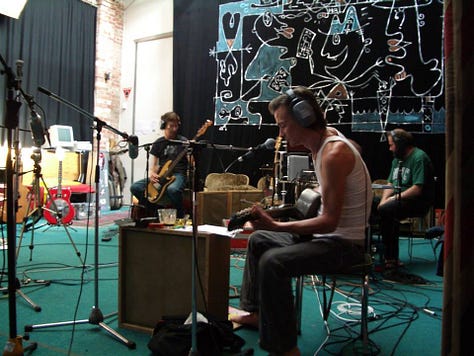
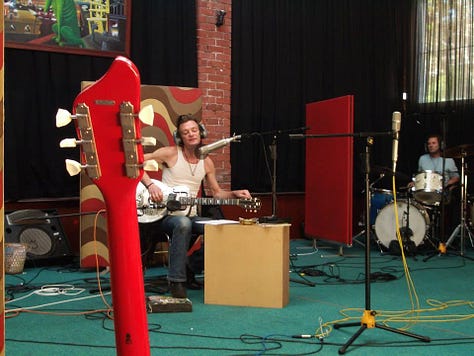
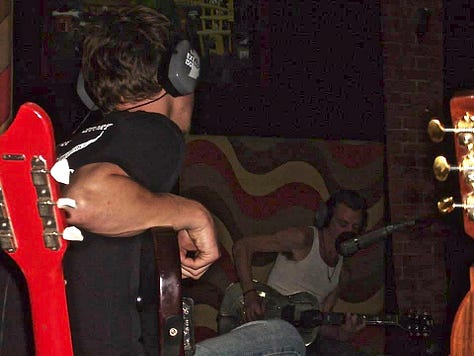
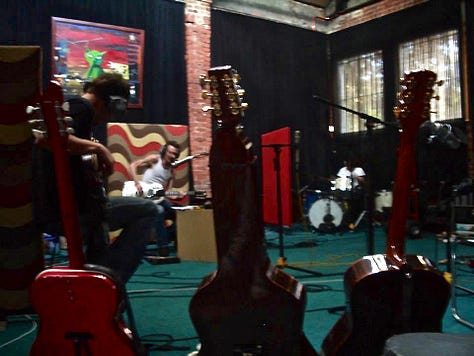

On the Salty Dog podcast, Jeff discussed how the title track “Dislocation Blues” was recorded, illustrating this technique, albeit in an open courtyard, not a closed recording studio:
“Motion Bride” was also recorded al fresco:
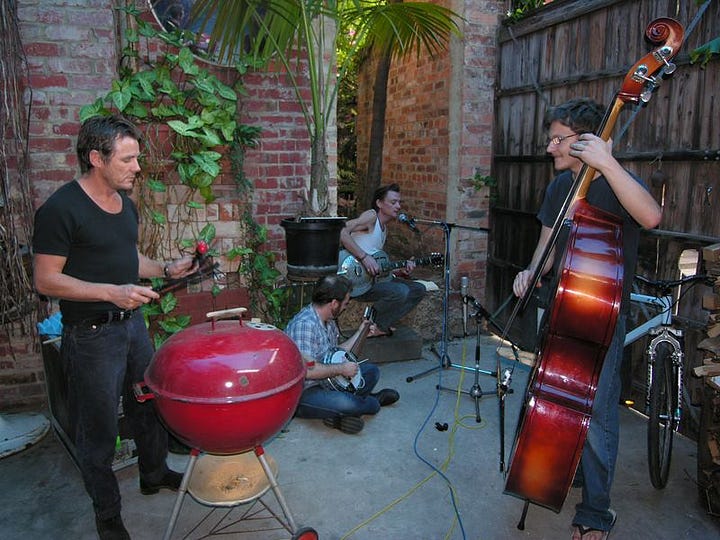
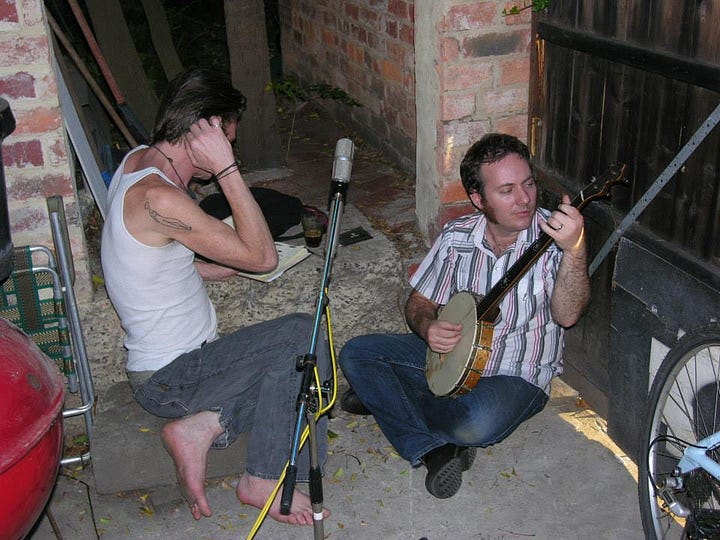
Lang’s production of Dislocation Blues puts the album squarely in what Jack Ferrick, in an insightful comment on a Popdose article, defined as a “performance album” (e.g., Dirt Floor, Hotel Vast Horizon): an album for which tracks are not “built” in a studio, but rather performed and recorded in a studio. In contrast, “an assembly album … uses the studio as a compositional tool—using it to develop the songs, rather than simply to decorate them (e.g., Terra Incognita, Rocket House).”
What Each Brought to Their Duo Effort
Now almost twenty years after the album’s release, I found it somewhat disconcerting to re-read what music reviewers wrote about Chris Whitley and Jeff Lang in their reviews of Dislocation Blues. So many critics framed the duo effort as the product of a student-teacher or acolyte/master relationship - Lang as student/acolyte, Whitley as teacher/master. I find that framing understates Lang’s at-the-time almost two-decades-long music career and his considerable skills and accolades. Both were accomplished recording artists, each of whom brought complementary skill sets and musical tastes to the endeavor.
Two Accomplished Artists
Both Lang and Whitley had dedicated themselves to their respective music careers when just 17 years old. The first decade of Whitley’s music career involved busking on NYC streets, playing in various Belgium-based bands, and leading another - A Noh Rodeo, which released one LP (Cool ‘n’ Groovy) and two singles. Of course, Whitley’s career took flight when, at 30 years of age, he signed a 3-album contract with Columbia Records in 1990. By the time he and Lang recorded Dislocation Blues, Whitley had 11 albums (two tracks from LWTL charted on Billboard) under his belt. Whitley also had played with major artists such as Cassandra Wilson (contributing guitar on two of her albums), Rob Wasserman & Les Claypool (a track on Wasserman’s Trios), and Bob Weir (The Grateful Dead); he also had recorded Perfect Day with Billy Martin and Chris Wood (Medeski Martin & Wood).
By his 30th birthday (1999), Lang had recorded over a half-dozen albums, including Native Dog Creek (1996 - named Best Australian Blues Album in Rhythms Magazine's readers poll) and Cedar Grove (1998 - nominated for ARIA’s Best Blues and Roots Album in 1999). While still in his early 30s, Lang was honored for Rolling Through This World, an album with Bob Brozman and Angus Diggs, which won ARIA’s Best Blues and Roots Album in 2002. Thus, although at their first meeting back in 1993 Lang was eager to learn from Chris’ musical journey, by 2005 Lang was well along his own journey, albeit at a younger age. Lang addressed this point on the Salty Dog podcast:
In my assessment, Lang’s career progressed at a faster pace and reflected his musical vision earlier than Whitley’s did. Although Whitley’s Belgium experience and years under a label contract produced much excellent music, it seems that fully developing his unique musical vision was delayed; in my opinion, Whitley did not take control of his musical path until he was dropped from Sony. As Lang notes in his memoir,
[Chris] expressed admiration for my having forged what he called a “totally hand-made career.” Having been through the wringer of the major label side of the tracks, he liked the idea of doing things on your own, rather than making a deal with the devil. Everything has its pros and cons of course, but I could see where he was coming from.
Complementing Each Other
Lang sings and tangles on slide with Whitley like a blood relative. [David Fricke - Rolling Stone]
[E]ach plays off the other with the ease and generosity of old friends sitting on the back porch. [Jason Schneider for Wood Wires and Whiskey]
Dislocation Blues … documents a fruitful collaboration between two masters of progressive blues music. Whitley and Lang contrast and complement each other in a natural and intuitive fashion. [PopMatters]
These pull quotes aptly summarize Chris Whitley and Jeff Lang’s collaboration. As Noel Mengel noted in his Dislocation Blues review,
It's not surprising they had so much common ground, since they both shared a love of blues, a love of Bob Dylan, both played a mean slide guitar and both were single-minded musical adventurers with a deep understanding of musical history yet not content merely to re-create past glories.4
Instruments: Whitley contributed his Nationals - a Style O and a Duolian. Lang played lap steel, National guitar, acoustic guitar, chumbush, fretted and fretless electric guitars, and fretless banjo. Critics highlighted both players’ slide dexterity, but also contrasted how they each employed their guitars, one noting that “[Whitley’s] National Steel sounds like it might slice the speakers. Lang's … licks, loops and samples unfailingly lay down an inspired sympathetic backdrop for Whitley's dark blues and eccentric tunings.”5 For example, as recorded for the duo’s album, “Rocket House” features both Whitley and Lang on Nationals; the only other ‘instrument’ is Whitley’s foot. Listen to the first minute or so as an example of how these men employed basically the same instrument to very different effect:
Lang’s guitar playing here brings to mind Whitley’s atmospheric guitar on e.g., Cassandra Wilson’s “I Can’t Stand the Rain.” As Audio Enz concluded, “Guitar fans need to have a listen to this as when these two start playing off each other the results are quite special.”6
Musicianship: When Classic Rock asked Lang if he thought Whitley was “a musician’s musician,” Lang responded,
It's funny, Chris never saw what he did as very 'musicianly' you know? He described his guitar style as 'clumsy', his use of open tunings as 'pragmatic'. … [H]is guitar style was really raw-sounding, yet harmonically adventurous, he had such an alluring, hard-to-pin-down way of writing where his vocal melodies, guitar playing and songwriting were so inextricably tied together that it was hard to separate them.
In contrast, Lang was much more “musicianly” - being versed in music theory and a highly-lauded master of a range of guitars. Numerous critics especially note his slide- and fret-work as being outstanding. Nonetheless, both are inventive, intuitive musicians, sometimes too much so as Jeff Giles explained in his review:
This sort of dismantling and reduction sets the tone for all of Dislocation Blues; Whitley and Lang strip covers, old originals, and new collaborations down to their most essential bits, run them through a rusty old blender, and repeat. It's intoxicating, and Lang deserves much of the credit for this. On his own, Whitley was apt to spend a lot of time doodling in the margins of melody and song structure; here, however, Lang acts as a tether and a foil, providing Whitley with a response to his ghostly call. Guitar fans - particularly those of the National and lap variety - will find a feast worth savoring here.7
Vocals: Reviewers describe both Whitley and Lang as having “breathy” vocals, but whereas Whitley’s are often “a dry, wizened voice,” “a distinctive, high resonating rasp,” and “half-whispered contemplations,” Lang’s are “sweet,” “soaring,” and “self-assured harmony.” Andrew Iliff describes Whitley’s vocals well: “Dislocation Blues leaves the sound of Chris Whitley's voice imprinted in the mind. Whitley has always sounded haunted and haunting in equal measure, but his aspirant, resonant rasp has never been more eerie or otherworldly.”8 A review in The Post-Gazette highlights Lang’s contribution: “Lang's mournful harmonies add depth and meaning. Plus you can actually understand the lyrics. Whitley's and Lang's vocal interplay as they move through the songs illustrate complementary voices, minds and moods. …[T]hey are haunting reminders of the pleasures of the human voice as emotional instruments.”9
It’s difficult to describe how Whitley and Lang complement each other, so it’s better to ‘show’ than to ‘tell.’ Here’s the duo playing “Kick the Stones” in Anchorage October 2004:
Whitley’s song - one of his most played and most requested - is excellent in itself, whether performed solo or with band. But Lang’s contribution - of what sounds like lap steel guitar - elevates, illuminates, reveals added dimensions and complements Whitley’s vocals in tone and phrasing.
An Australian production at https://salty.com.au/. Jeff appeared in 2007; I captured the audio in January 2017.
Wes Orshoski, “Whitley Shines On Final Recording Sessions,” Billboard, April 16, 2007.
I captured this and other audio segments over a decade ago from a podcast Jeff Lang produced and shared on his website to promote Dislocation Blues. The podcast does not seem to be available now.
Noel Mengel, “Dislocation Blues,” The Courier-Mail (Brisbane), August 31, 2006.
Julian Piper, Guitarist Magazine (UK), June 2007 captured from Jeff Lang’s website in 2013.
Craig Fenemor, “Dislocation Blues,” AudioEnz (New Zealand) captured from Jeff Lang’s website in 2013.
Jeff Giles, “Chris Whitley’s ‘Dislocation Blues’,” bullz-eye.com. View on the Internet Archive’s Way back Machine: https://web.archive.org/web/20140911112906/http://www.bullz-eye.com/cdreviews/giles/chris_whitley_and_jeff_lang-dislocation_blues.htm
Andrew Iliff, “Chris Whitley & Jeff Lang: Dislocation Blues,” Stylus Magazine, October 24, 2006.
"Chris Whitley's 'Dislocation Blues' Paints a Masterpiece,” The Pittsburgh Post-Gazette, April 6, 2007.


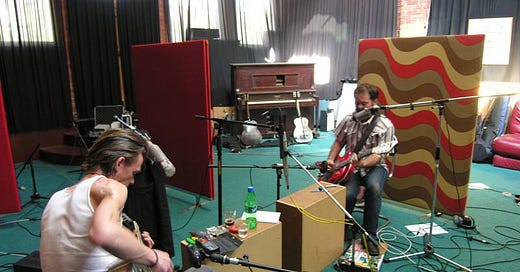


Great piece! I love hearing more about this record. But I didn't know Velocity Girl was an old song, was it one that popped up in bootlegs that he'd played live for quite a few years or did it come out previously on something I missed?
Jeff Lang digs The Scientists! There’s a band who I’d never associated with Lang or Whitley.
The Scientists were an excellent band, aggressively psychedelic and swampy, the loudest band I’ve ever heard.
Their paisley shirts were louder than their music!
Their mention brings back very joyous memories of seeing them at the sadly-missed Trade Union Club here in Sydney.
I also saw them once in London in the mid-1980s; my strongest memory is of an audience member’s proto-crowd-surfing attempt go comically wrong.